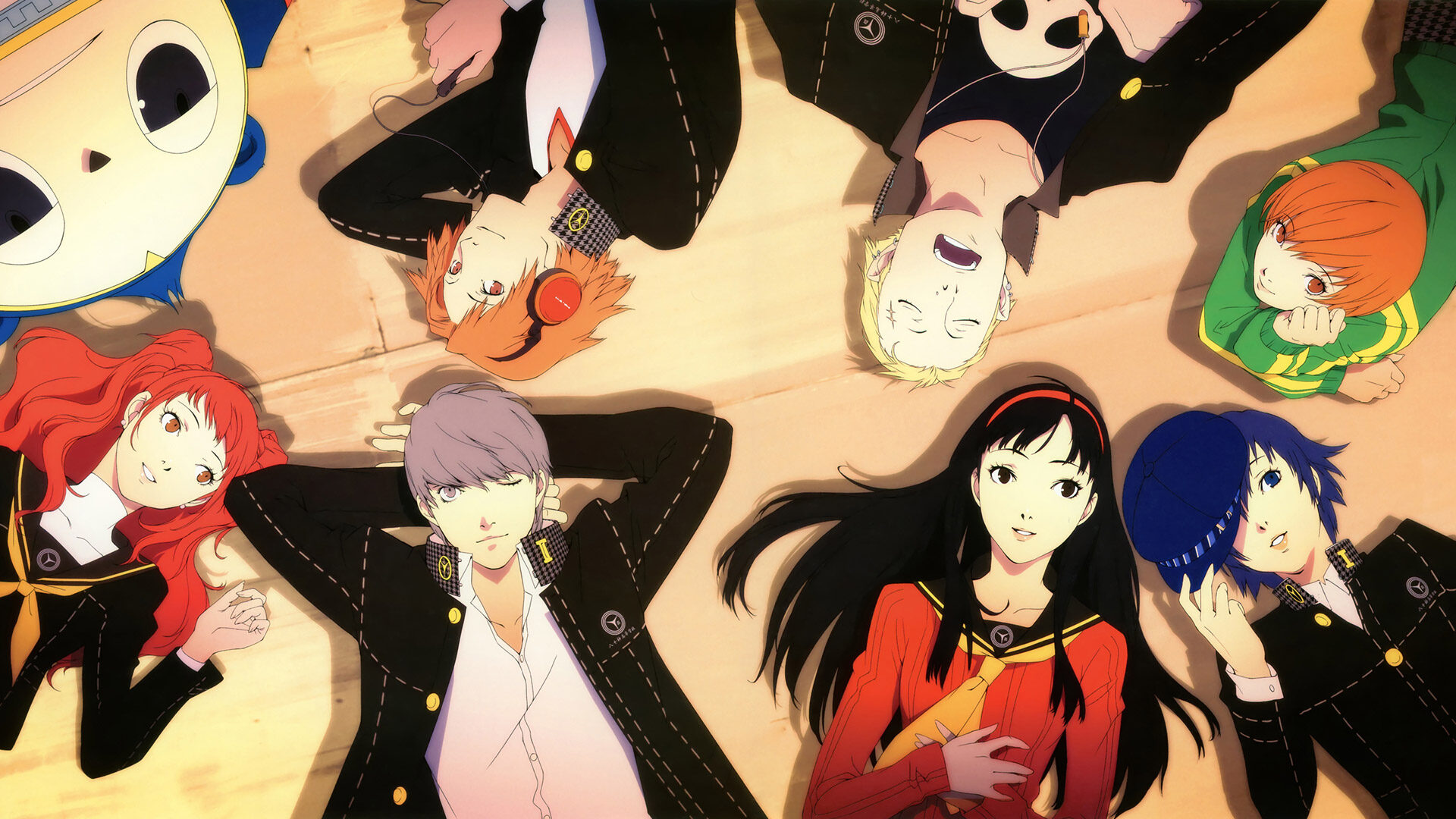Persona 4 Review
Each character is a tragic hero, and yet, they are at their core nothing more than ordinary people thrown into extraordinary situations. Because of this, we can relate to them, progress with them, live the adventure that is Persona through them.
Eleven years ago, I wrote those words as part of the opening to the official GameFan strategy guide for a quirky new RPG brought to the United States by Atlus called Revelations: Persona. It is funny that they would then end up being at their most relevant nearly a decade later at the release of the franchise’s third official chapter, Persona 3.
Persona 3 was the game that changed things for me. Truth be told, I hadn’t been so happy with the Japanese RPG genre over recent years; a genre I came to love from the 8-bit days of Phantasy Star and Dragon Warrior, and a genre I watched fall into stagnation as generations passed but each new title did little to progress itself over its forefathers. P3 may not have been the phoenix rising from the ashes of outdated ideas and cliches that I longed to see, but it was the game to stand up and challenge us to look at things in a whole new perspective, just as the original Persona had done so long ago.
And it was this love for the game that gave me back my faith that made me wonder if I had made a horrible mistake in pushing so hard to have Persona 4 be our cover story for this month.
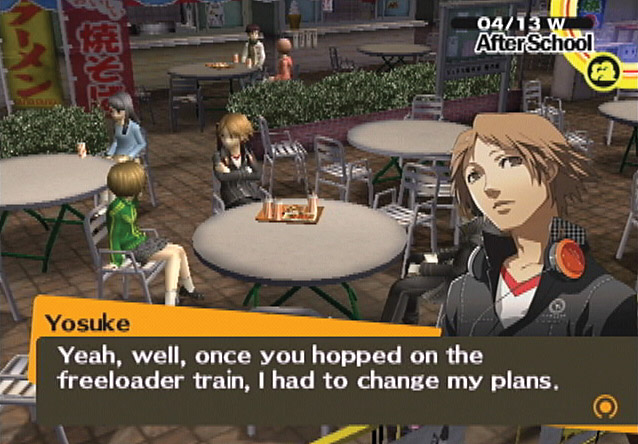
The first person in Persona 4 to officially join our protagonist in his adventures is a young lad by the name of Yosuke. Like you, Yosuke is originally from the big city, brought to the sleepy Japanese town of Inaba due to his father’s managerial position at the recently-opened mega store Junes. (Junes is the Wal-mart of the gaming world: the “evil” big-box retailer who comes in with little concern for the fate of those smaller local stores that have existed for as long as one can remember.) Yosuke’s awakening to the power of persona–those inner selves of ours that give us strength beyond what we normally can achieve–doesn’t come as it has come before, which typically amounts to a trumpet of fanfare and a “here kid, here’s your persona, now go save the world” for good measure. Instead, it comes in a scene where Yosuke is forced to not only face those feelings and emotions he has kept bottled up inside of him, but fight that inner self after initially refusing to acknowledge that other self as his own. This would be the way all of the main characters in P4 (save our protagonist) would be awarded their power, and it’s a subtle change that ends up really setting the stage for where the game intends to take you.
I mention this facet of Persona 4 here now because it is key to what I myself had to come to understand, and what those out there who were fans of Persona 3 will have to face in themselves. As excited and enthusiastic as I was going in, an hour or so into P4, I wasn’t enjoying it, and that’s because the true feeling I had buried in my heart that I refused to accept was that I didn’t want to like it better than P3. Had this been a completely new project, different in detail and design from its previous chapter, I could have left those feelings for P3 where they lay, and enjoyed P4 without any of that comparison going on in my mind. The truth is, P4 is indeed, as some have labeled it, “Persona 3.5”. It is not a revolutionary project that will leave you with the same feelings of wonder and surprise that you felt with P3 (unless you haven’t played P3); it is instead the progression of what was started in that rebirth of the Persona series, and what was built upon in FES.
I had loved Persona 3, and I always will, and that’s okay. At some point, though, I had to let it go, and I had to accept Persona 4 for what it was without wanting it to be something it wasn’t.
What I can now say with confidence is that while Persona 4 may be a better technical game (in most respects) than Persona 3, what is far more important is that it is a better experience. While there are many reasons for this, the absolute biggest contributor is the strength of the cast we have been given here, a strength nowhere displayed as brilliantly as it is in Chie Satonaka. Chie is quite possibly is one of the best characters ever to come from Atlus, Megami Tensei series or otherwise, and if she doesn’t go on to become a fan favorite in the category of female RPG characters, it will be proof that there is no justice in this world. From the moment I met her, I fell in love with Chie as a character–not because the game was trying with all of its might to convince me that I liked her, as P3 struggled to do with Yukari, but because she simply works so amazingly well. She is, at her core, nothing more than your average girl, a person that you could actually bump into one day while browsing VHS tapes of kung-fu movies recorded from Chinese TV on the shelf of some poorly-lit Asian video store somewhere. Chie has no tragic flaw waiting to show itself, no dark secret past soon to surface; she is just a girl who can be strong, but is never invincible; who can be weak, but is never breakable; who can be a dork, but is never dumb. When it came time to decide which I wanted to pursue her as–either a love interest or a close friend, a new option you’re given in P4 for the major female characters instead of just automatically trying to get your groove on with all of them–because I had so grown to respect her as a comrade and a friend, and didn’t want to cheapen that by feeling forced to switch her over to romance status. (Well, that, and my eye was instead on a certain red-haired ex-idol.)
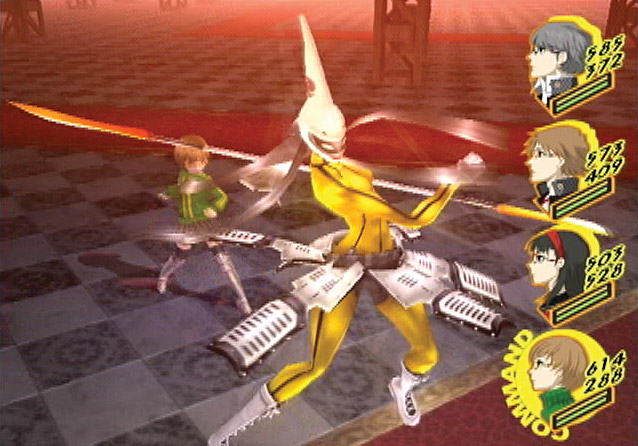
What Persona 4 does in Chie, and in the entire rest of the cast, is allow the characters to simply be, for lack of a better word, “normal”. P3‘s cast, as much as I loved them, each held in themselves classic stereotypes from the world of Japanese gaming and anime: the goofy slacker, the mature older girl, the cool upperclassman all the students look up to, the shy, frail girl who has trouble fitting in. Those characters, throughout the course of P3, had to be given opportunities to show that there was more to them than just those cookie-cutter positions. The people you’ll come to know in P4 aren’t tragic heroes pushed into a situation they never wanted to be in, they’re down to earth high schoolers who are eager to use their powers to save those around them, yet who are also perfectly capable of forgetting their troubles when the opportunity to have fun arises. In stripping away that desperation of having the entire world balance on their shoulders, these heros and heroines have become far more relatable, and in turn, also more endearing.
It’s nice, then, to see that one of the changes made to Persona‘s current claim to fame, the Social Link system, is an increased importance on those closest to you. As before, your best female friends are more than eager to grow their relationships with you, but now so to are your male teammates. This initially makes the overall head count when it comes to Social Links feel artificially smaller, because a decent chunk of your possible acquaintances are already accounted for. What you find, however, is that your Social Links now have more emotional value to them, and while you’ll be spending more time with your close circle of friends because of the benefits they’ll gain in combat (which we’ll get to in a moment), but also because those are the people you most want to spend time with. Thought a few aspects of the overall social experience don’t quite feel as robust as or improved upon thought that were in Persona 3 as they should–outings with friends don’t feel as spontaneous, and events like the summer festival or school culture day are still woefully under-developed–there are a greater amount of elements that have either been nicely expanded or are completely new. Stat-boosting situations can now improve your standing with multiple characters at once, and a wide variety of jobs and side tasks now exists when you’ve got some time on your hands and nothing to do otherwise.
The changes made to Persona 4‘s social side are by far the biggest differences you’ll find when compared to Persona 3, but they certainly aren’t the only ones. Tartarus–the 250+ floor dungeon that served as the setting for most of P3‘s combat-related gameplay–was somewhat of a sticking point for some. P4 goes away from the idea of an all-encompassing location, and instead gives players smaller, much more personalized dungeons based around the personally of the characters you’re trying to save at that point. (An idea crafted to brilliance in the game’s fourth dungeon.) Coming from the monstrous Tartarus, at first they’ll feel positively tiny, but the change in attitude and atmosphere they create is unquestionably positive. Those who enjoyed the dungeon crawling of P3 should still find enough here to be satisfied, but those who found that aspect a chore will no doubt be happy to see that source of exhaustion changed into a more enjoyable experience.
Much bigger of a shock, surprisingly, was what you’ll find new this time around once you’ve actually encountered a Shadow in said dungeons. Little tweaks to the core elements of battle mean that some previous strategies no longer exist, and the addition of new skills that your teammates can unlock as you progress their Social Links–such as pushing your character out of the way of a mortal blow, or curing another character of a status ailment after a knock-down attack for free–provide an interesting extra layer not only to battle, but the overall feeling of a team working together in itself. And, speaking of teamwork, we get to that bullet-point that rests near the top of any list detailing the changes in Persona 4: the ability to directly control your party members should you decide to. I am, I must say, a bit torn on this one. Some folks out there do not at all like the notion of A.I.-controlled characters in RPGs, and will be happy to know that they can now have full say at all times over their characters in P4. As somebody who very much supports the A.I. teammate route, people like me will find the results mixed: your party members are wonderfully smarter than they were before, but the amount of specific strategies you can have a character follow has been reduced. No doubt the thought is that more specific control should now come from, well, direct control. While not a deal breaker, those like myself who would prefer to not fall back on the direct control crutch will find it near impossible to avoid that temptation in a few of the boss battles.
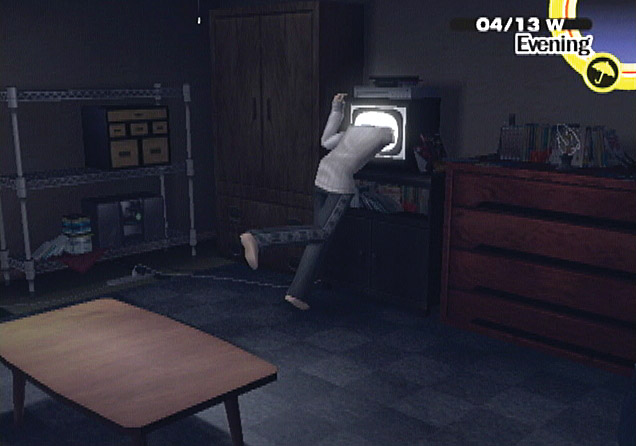
There is, unfortunately, one point of serious concern with Persona 4, and it is something that I, in my infinite wisdom, predicted back in my review for Persona 3:
If Persona 3 has one major flaw, it is the point at which the harsh realization sets in that this game is too ambitious for its own good… As heartbroken as I may be, I can’t blame Persona 3 for not being more than it set out to be, because it took a lot of chances and really pulled off everything it attempted. Instead, I blame the game for now making me want a Persona 4 that would probably be financially (and logistically) impossible for Atlus to produce.
Persona 4 is absolutely, unquestionably an amazing game. When nostalgia is put aside and it is compared to Persona 3, P4 is truly the better game, and taking into account that I consider P3 to be one of the best PS2 titles ever to see release, that’s saying something. And yet, even as much as I came to embrace the game once I opened my heart to it, I just couldn’t help but feel like I wasn’t fully satisfied. With P3, I expected nothing, and ended up with more than I could have imagined. With P4, I knew what I wanted, and when the meal was finished, I was left hungry. What has been crafted here is quality from beginning to end, but the can–no, must–be more. The player’s interaction with the characters in the game must be richer, as too must the situations we are presented. I don’t want to watch my character having fun at a class outing via a few lines of text, I want to have that fun myself. I don’t want to wait to pre-set days in order to deepen my relationships with people, I want to use the cell phone my character always has at hand to call them up and invite them out. I want my character to find love that actually results in a relationship, not just a blushing character pic and a few slightly different final events. (I’d also, by the way, like to help those teammates who aren’t part of such dating situation find love themselves.)
Persona 4 is the pinnacle of the Persona series, a journey of 11+ years that has come so far and now shines so bright. For a series that has become so focused on the development of relationships, however, it itself must now develop in what it provides us from those relationships. Otherwise, as good as Persona 4 may be, I’m not sure I can fully support the idea of a Persona 5.
P.S. – Atlus, I love you for Persona 4‘s Square button. (Readers, you’ll understand when you play.) But seriously… we need to talk about long, drawn out story sequences before boss battles that cannot in any way be skipped other than mashing a button. When I’m heading in for my fifth attempt at a boss, I don’t need to see that anymore.
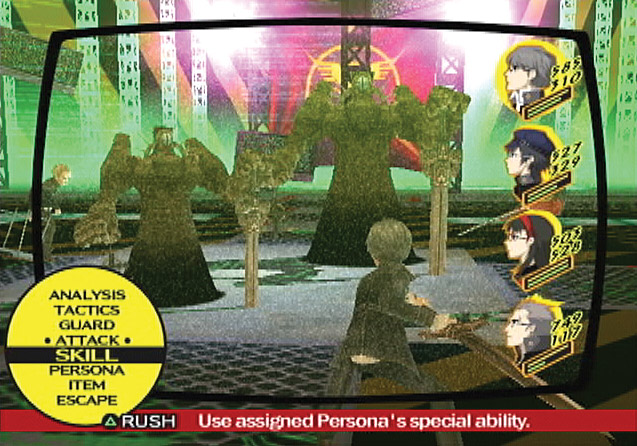
| A Great | Persona 4 is the pinnacle of the Persona series, a journey of 11+ years that has come so far and now shines so bright. For a series that has become so focused on the development of relationships, however, it itself must now develop in what it provides us from those relationships. |
| Persona 4 was reviewed using review code, physical copies, or hardware provided by Atlus. Scores are graded on a scale of E (Bad) to S (Special) in homage to Japanese video game grading scales, with the understanding that an S still does not denote a "perfect" score. Scores may have been adjusted from the original source to better fit my personal scale. | |
